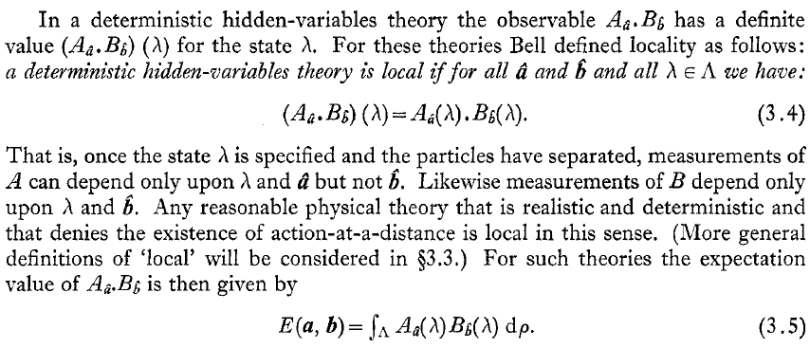A post titled "Is it impossible to violate the Bell-CH inequallities", concluded:
When you work out the other terms, the middle of the inequality becomes
p12(a,b) - p12(a, b' ) + p12(a' , b) + p12(a' , b' ) - p1( a' ) - p2( b) = p1(a) - 0 + p1(a' ) + p1(a' ) - p1(a' ) - p1 (a) = p1(a`) ,
which is always strictly positive unless p1(a' ) = 0, and p1(a' ) can be chosen arbitrarily.
This is all fine except for the very last assertion that "p1(a' ) "can be chosen arbitrarily". I had overlooked a consistency condition which requires that p1(a' ) = 1/2. The same condition requires that all of the probabilities be 1/2 except that p12(a, b' ) = 0. (To understand why p12(a, b' ) is different, recall that p12(a, b' ) is the probability that Alice and Bob both obtain result +1, but the condition A = (not B' ) says that they never both obtain the same result.) That is,
p1(a) = p1(a' ) = p1(b) = p1(b' ) = p12(a,b) = p12(a' , b) = p12(a' , b' ) = 1/2, but p12(a, b' ) = 0.
The counterexample is still valid under these choices of the probabilities, and even easier to check:
the middle term is 1/2 > 0.
In another reply, someone asked how one can obtain these probabilities from quantum mechanics (QM). One can't; QM does not allow Popescu/Rohlich (PR) boxes. But QM does allow what I called "probabilistic PR boxes", as discussed in a previous post on PR boxes (my post discussing the Kwiat/Hardy "quantum cakes" paper). A "probabilistic PR box" has the same (classically) contradictory features as a PR box, but one of the four defining conditions,
A = B, B = A', A' = B', B' = (not A),
only occurs with some nonzero probability (for Kwiat/Hardy, that probability is about .09) instead of occurring with probability 1 as in a genuine PR box.
Also, there seems to be some misunderstanding that the CH or CHSH inequalities may have something to do with classical or quantum mechanics. They have nothing to do with classical or quantum mechanics. They are purely mathematical theorems stating a necessary condition that certain hypothetical "marginals" like p12(a,b) and p1(a) really are marginals of some probability distribution which was previously denoted as




